Electrical Characteristics of Ultra-High-Performance Concrete Containing Carbon-Based Materials
Abstract
1. Introduction
2. Materials and Methods
2.1. Mix Proportions and Materials
2.2. Direct Current Measurements
2.3. Alternating Current Measurements
3. Results and Discussions
3.1. Compressive Strength
3.2. Tensile Strength
3.3. Direct Current Measurements
3.4. Alternating Current Measurements
4. Conclusions
Author Contributions
Funding
Institutional Review Board Statement
Informed Consent Statement
Conflicts of Interest
References
- Ingrid, L.L.; Ida, G.A.; Reyn, O.B.; Katalin, V.; Rein, T.T. Determining the Environmental Benefits of Ultra High Performance Concrete as a Bridge Construction Material. IOP Conf. Ser. Mater. Sci. Eng. 2017, 245, 052096. [Google Scholar]
- Park, S.Y.; Kim, B.S. State-of-the-art of Ultra-High Performance Concrete Bridges. Mag. Korea Concr. Inst. 2016, 28, 31–35. [Google Scholar]
- Xiao, S.; Suleiman, M.T.; Naito, C.J.; Neti, S. Use of Geothermal Deep Foundations for Bridge Deicing. Transp. Res. Rec. 2013, 2363, 56–65. [Google Scholar] [CrossRef]
- Koch, G.H.; Brongers, M.P.H.; Thompson, N.G.; Virmani, Y.P.; Payer, J.H. Corrosion Costs and Prevention Strategies in the United States; FHWA-RD-01-156; FHWA, U.S. Department of Transportation: Washington, DC, USA, March 2002.
- Ga, S.J.; Yoo, S.W.; Choi, Y.C. Heating and Mechanical Properties of MWCNT Reinforced Cement Composites. J. Korea Concr. Inst. 2021, 33, 49–56. [Google Scholar] [CrossRef]
- Tanaka, K.; Sato, T.; Yamabe, T.; Okahara, K.; Uchida, K.; Yumura, M.; Niino, H.; Ohshima, S.; Kuriki, Y.; Yase, K.; et al. Electronic Properties of Carbon Nanotube. Chem. Phys. Lett. 1994, 223, 65–68. [Google Scholar] [CrossRef]
- Ruoff, R.S.; Lorents, D.C. Mechanical and Thermal Properties of Carbon Nanotubes. Carbon 1995, 33, 925–930. [Google Scholar] [CrossRef]
- Salvetat, J.P.; Bonard, J.M.; Thomson, N.H.; Kulik, A.J.; Forro, L.; Benoit, W.; Zuppiroli, L. Mechanical Properties of Carbon Nanotubes. Appl. Phys. A 1999, 69, 255–260. [Google Scholar] [CrossRef]
- Farcas, C.; Galao, O.; Navarro, R.; Zornoza, E.l.; Baeza, F.J.; Moral, B.D.; Pla, R.; Garcés, P. Heating and De-icing Function in Conductive Concrete and Cement Paste with the Hybrid Addition of Carbon Nanotubes and Graphite Products. Smart Mater. Struct. 2021, 30, 045010. [Google Scholar] [CrossRef]
- Wang, Z.; Yu, J.; Li, G.; Zhang, M.; Leung, C.K.Y. Corrosion Behavior of Steel Rebar Embedded in Hybrid CNTs-OH/polyvinyl Alcohol Modified Concrete under Accelerated Chloride Attack. Cem. Concr. Compos. 2019, 100, 120–129. [Google Scholar] [CrossRef]
- Reddy, P.N.; Kavyateja, B.V.; Jindal, B.B. Structural health monitoring methods, dispersion of fibers, micro and macro structural properties, sensing, and mechanical properties of self-sensing concrete—A review. Struct. Concr. 2021, 22, 793–805. [Google Scholar] [CrossRef]
- Lee, S.H.; Han, S.J.; Jang, B.S.; Kim, K.S.; Seo, S.Y. Evaluation of Self-Sensing Performance of UHPC with Carbon Nanotube. J. Korea Concr. Inst. 2020, 32, 505–512. [Google Scholar] [CrossRef]
- Wang, Y.Y.; Tan, Y.Q.; Liu, K.; Xu, H.N. Preparation and Electrical Properties of Conductive Asphalt Concretes Containing Graphene and Carbon Fibers. Constr. Build. Mater. 2022, 318, 125875. [Google Scholar] [CrossRef]
- Heydar, D.; Kemalettin, Y.; Metin, I. Evaluation of Recycled Nano Carbon Black and Waste Erosion Wires in Electrically Conductive Concretes. Constr. Build. Mater. 2019, 221, 109–121. [Google Scholar]
- Sassani, A.; Ceylan, H.; Kim, S.H.; Gopalakrishnan, K.; Arabzadeh, A.; Taylor, P.C. Influence of Mix Design Variables on Engineering Properties of Carbon Fiber-Modified Electrically Conductive Concrete. Constr. Build. Mater. 2017, 152, 168–181. [Google Scholar] [CrossRef]
- Kim, H.S.; Ban, H.; Park, W.-J. Deicing Concrete Pavements and Roads with Carbon Nanotubes (CNTs) as Heating Elements. Materials 2020, 13, 2504. [Google Scholar] [CrossRef] [PubMed]
- Huang, H.; Xu, J.; Yao, A.; Xia, W.; Bai, E.; Ning, Y. Study on Microwave Deicing of Carbon-Fiber-Modified Concrete under Multi-Factor Coupling Effect. Appl. Sci. 2022, 12, 5551. [Google Scholar] [CrossRef]
- Lim, C.S.; Lee, J.J.; Choi, M.J.; Kim, D.H. Fundamental study of carbon fiber sheet’s heating behavior in concrete. In Proceedings of the Korean Institute of Metals and Materials (KIM) 2016 Spring Conference, Jeollanam-do, Korea, 27–29 April 2016; Volume 28, pp. 701–702. [Google Scholar]
- Haghgoo, M.; Ansari, R.; Hassanzadeh-Aghdam, M.L.; Nankali, M. Analytical Formulation for Electrical Conductivity and Percolation Threshold of Epoxy Multiscale Nanocomposites Reinforced with Chopped Carbon Fibers and Wavy Carbon Nanotubes Considering Tunneling Resistivity. Compos. Part A Appl. Sci. Manuf. 2019, 126, 105616. [Google Scholar] [CrossRef]
- Chen, M.; Sun, Y.; Liang, J.; Zeng, G.; Li, Z.; Tang, L.; Zhu, Y.; Jiang, D.; Song, B. Understanding the Influence of Carbon Nanomaterials on Microbial Communities. Environ. Int. 2019, 126, 690–698. [Google Scholar] [CrossRef]
- Adhikary, S.K.; Rudzionis, Z.; Ghosh, R. Influence of CNT, graphene nanoplate and CNT-graphene nanoplate hybrid on the properties of lightweight concrete. Mater. Today Proc. 2021, 44, 1979–1982. [Google Scholar] [CrossRef]
- Siahkouhi, M.; Razaqpur, G.; Hoult, N.A.; Baghban, M.H.; Jing, G. Utilization of carbon nanotubes (CNTs) in concrete for structural health monitoring (SHM) purposes: A review. Constr. Build. Mater. 2021, 309, 125137. [Google Scholar] [CrossRef]
- Gao, Y.; Jing, H.; Zhao, Z.; Shi, X.; Li, L. Influence of ultrasonication energy on reinforcing-roles of CNTs to strengthen ITZ and corresponding anti-permeability properties of concrete. Constr. Build. Mater. 2021, 303, 124451. [Google Scholar] [CrossRef]
- Jung, M.J.; Lee, Y.S.; Hong, S.G. Study on Improvement in Electromagnetic Interference Shielding Effectiveness of Ul-tra-High Performance Concrete (UHPC)/Carbon Nanotube (CNT) Composites. J. Korea Concr. Inst. 2019, 31, 69–77. [Google Scholar] [CrossRef]
- Oh, S.W.; Oh, K.S.; Jung, S.H.; Chung, W.S.; Yoo, S.W. Effects of CNT Additions on Mechanical Properties and Micro-structures of Cement. J. Korea Inst. Struct. Maint. Insp. 2017, 21, 162–168. [Google Scholar]
- Piro, N.S.; Salih, A.; Hamad, S.M.; Kurda, R. Comprehensive multiscale techniques to estimate the compressive strength of concrete incorporated with carbon nanotubes at various curing times and mix proportions. J. Mater. Res. Technol. 2021, 15, 6506–6527. [Google Scholar] [CrossRef]
- Zhang, Z.; Shi, G.; Wang, S.; Fang, X.; Liu, X. Thermal Energy Storage Cement Mortar Containing n-octadecane/expanded Graphite Composite Phase Change Material. Renew. Energy 2013, 50, 670–675. [Google Scholar] [CrossRef]
- Frąc, M.; Pichór, W. Piezoresistive Properties of Cement Composites with Expanded Graphite. Compos. Commun. 2020, 19, 99–102. [Google Scholar] [CrossRef]
- McCarter, W.J.; Curran, P.N. The Electrical Response Characteristics of Setting Cement Paste. Mag. Concr. Res. 1984, 36, 42–49. [Google Scholar] [CrossRef]
- Shin, S.W.; Hwang, G.R.; Lee, C.J. Electrical Impedance Response Model of Concrete in Setting Process. J. Korean Soc. Saf. 2014, 29, 116–122. [Google Scholar] [CrossRef][Green Version]
- Cui, Y.; Wang, L.; Liu, J.; Liu, R.; Pang, B. Impact of Particle Size of Fly Ash on the Early Compressive Strength of Concrete: Experimental Investigation and Modelling. Constr. Build. Mater. 2022, 323, 126444. [Google Scholar] [CrossRef]
- Dhanesh, S.; Kumar, K.S.; Maruthur, P.; Rejumon, R.; Usmansha, G.S. Experimental Investigation of Strength of Aramid Kelvar and Chopped Carbon Reinforced Concrete Beam. Mater. Today Proc. 2021, 45, 1269–1273. [Google Scholar] [CrossRef]
- Pichór, W.; Frąc, M.; Radecka, M. Determination of Percolation Threshold in Cement Composites with Expanded Graphite by Impedance Spectroscopy. Cem. Concr. Compos. 2022, 125, 104328. [Google Scholar] [CrossRef]
- Wei, J.; Zhao, L.; Zhang, Q.; Nie, Z.; Hao, L. Enhanced Thermoelectric Properties of Cement-based Composites with Expanded Graphite for Climate Adaptation and Large-scale Energy Harvesting. Energy Build. 2018, 159, 66–74. [Google Scholar] [CrossRef]
- Mohsen, M.O.; Taha, R.; Taqa, A.A.; Shaat, A. Optimum Carbon Nanotubes’ content for Improving Flexural and Compressive Strength of Cement Paste. Constr. Build. Mater. 2017, 150, 395–403. [Google Scholar] [CrossRef]
- Chaipanich, A.; Nochaiya, T.; Wongkeo, W.; Torkittikul, P. Compressive Strength and Microstructure of Carbon Nanotubes Fly Ash Cement Composites. Mater. Sci. Eng. A 2010, 527, 1063–1067. [Google Scholar] [CrossRef]
- Guloglu, G.E.; Altan, M.C. Moisture Absorption of Carbon/Epoxy Nanocomposites. J. Compos. Sci. 2020, 4, 21. [Google Scholar] [CrossRef]
- Fang, H.; Gu, M.; Zhang, S.; Jiang, H.; Fang, Z.; Hu, J. Effects of Steel Fiber and Specimen Geometric Dimensions on the Mechanical Properties of Ultra-High-Performance Concrete. Materials 2022, 15, 3027. [Google Scholar] [CrossRef]
- Jang, S.J.; Yun, H.D. Effects of Curing Age and Fiber Volume Fraction on Flexural Behavior of High-Strength Steel Fiber-Reinforced Concrete. J. Korean Soc. Hazard Mitig. 2016, 16, 15–21. [Google Scholar] [CrossRef]
- Meng, S.; Jiao, C.; Ouyang, X.; Niu, Y.; Fu, J. Effect of Steel Fiber-Volume Fraction and Distribution on Flexural Behavior of Ultra-high Performance Fiber Reinforced Concrete by Digital Image Correlation Technique. Constr. Build. Mater. 2022, 320, 126281. [Google Scholar] [CrossRef]
- Raju, R.A.; Lim, S.; Akiyama, M.; Kageyama, T. Effects of Concrete Flow on the Distribution and Orientation of Fibers and Flexural Behavior of Steel Fiber Reinforced Self-compacting Concrete Beams. Constr. Build. Mater. 2020, 262, 119963. [Google Scholar] [CrossRef]
- Esmaeili, J.; Andalibi, K.; Gencel, O. Mechanical Characteristics of Experimental Multi-scale Steel Fiber Reinforced Polymer Concrete and Optimization by Taguchi Methods. Constr. Build. Mater. 2021, 313, 125500. [Google Scholar] [CrossRef]
- Kim, J.J.; Yoo, D.Y. Effects of Fiber Shape and Distance on the Pullout Behavior of Steel Fibers Embedded in Ultra-high-performance Concrete. Cem. Concr. Compos. 2019, 103, 213–223. [Google Scholar] [CrossRef]
- Abreu, F.S.; Ribeiro, C.C.; Pinto, J.D.S.; Nsumbu, T.M.; Buono, V.T.L. Influence of Adding Discontinuous and Dispersed Carbon Fiber Waste on Concrete Performance. J. Clean. Prod. 2020, 273, 122920. [Google Scholar] [CrossRef]
- Yan, S.; He, P.; Jia, D.; Yang, Z.; Duan, X.; Wang, S.; Zhou, T. Effect of Fiber Content on the Microstructure and Mechanical Properties of Carbon Fiber Felt Reinforced Geopolymer Composites. Ceram. Int. 2016, 42, 7837–7843. [Google Scholar] [CrossRef]
- Ahn, K.L.; Jang, S.J.; Jang, S.H.; Yun, H.D. Effects of Aggregate Size and Steel Fiber Volume Fraction on Compressive Behaviors of High-Strength Concrete. J. Korea Concr. Inst. 2015, 27, 228–235. [Google Scholar]
- Madhavi, T.C.; Annamalai, S. Electrical Conductivity of Concrete. ARPN J. Eng. Appl. Sci. 2016, 11, 5979–5982. [Google Scholar]
- Wei, X.; Li, Z. Early Hydration Process of Portland Cement Paste by Electrical Measurement. J. Mater. Civ. Eng 2006, 18, 99–105. [Google Scholar] [CrossRef]
- Zheng, Z.; Wei, X. Mesoscopic Models and Numerical Simulations of the Temperature Field and Hydration Degree in Early-age Concrete. Constr. Build. Mater. 2021, 266, 121001. [Google Scholar] [CrossRef]
- Maria, S.K.; Chrysoula, A.A. Self-sensing Carbon Nanotube (CNT) and Nanofiber (CNF) Cementitious Composites for Real Time Damage Assessment in Smart Structures. Cem. Concr. Compos. 2014, 53, 162–169. [Google Scholar]
- Maria, S.K.; Georgios, B.; Panagiotis, A.D.; Angeliki, K.Z.; Eugenia, K.Z.; Maria, G.F.; Surendra, P.S. Effect of CNT and CNF Loading and Count on the Corrosion Resistance, Conductivity and Mechanical Properties of Nanomodified OPC mortars. Constr. Build. Mater. 2017, 147, 48–57. [Google Scholar]
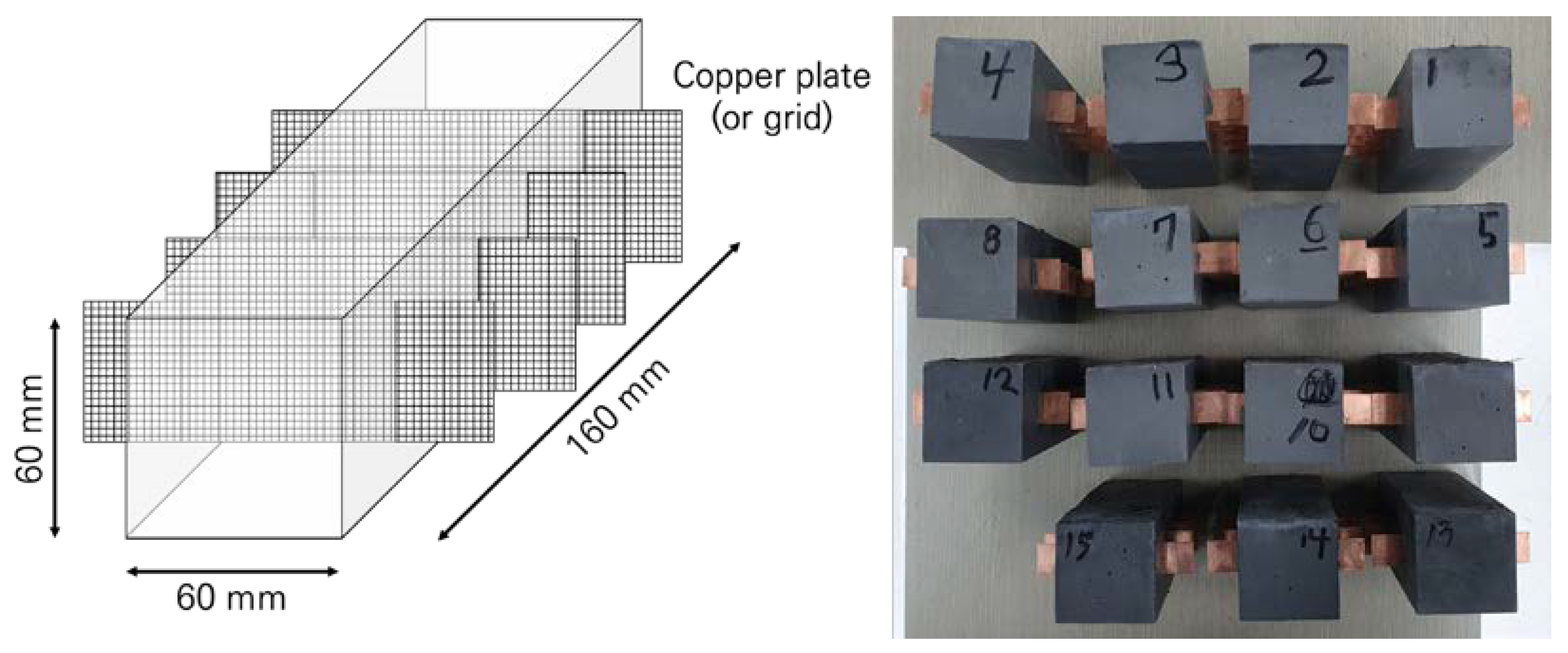

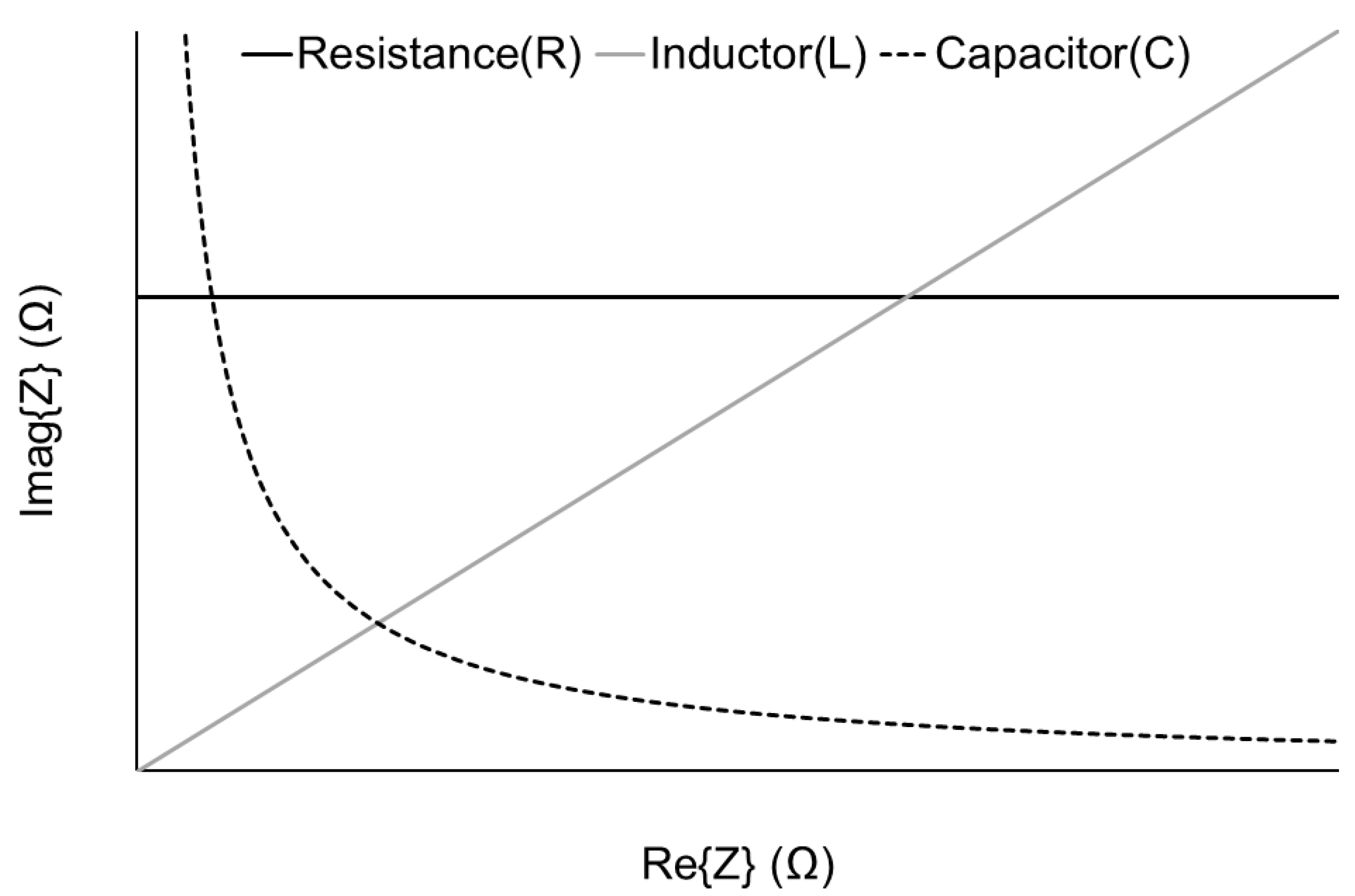
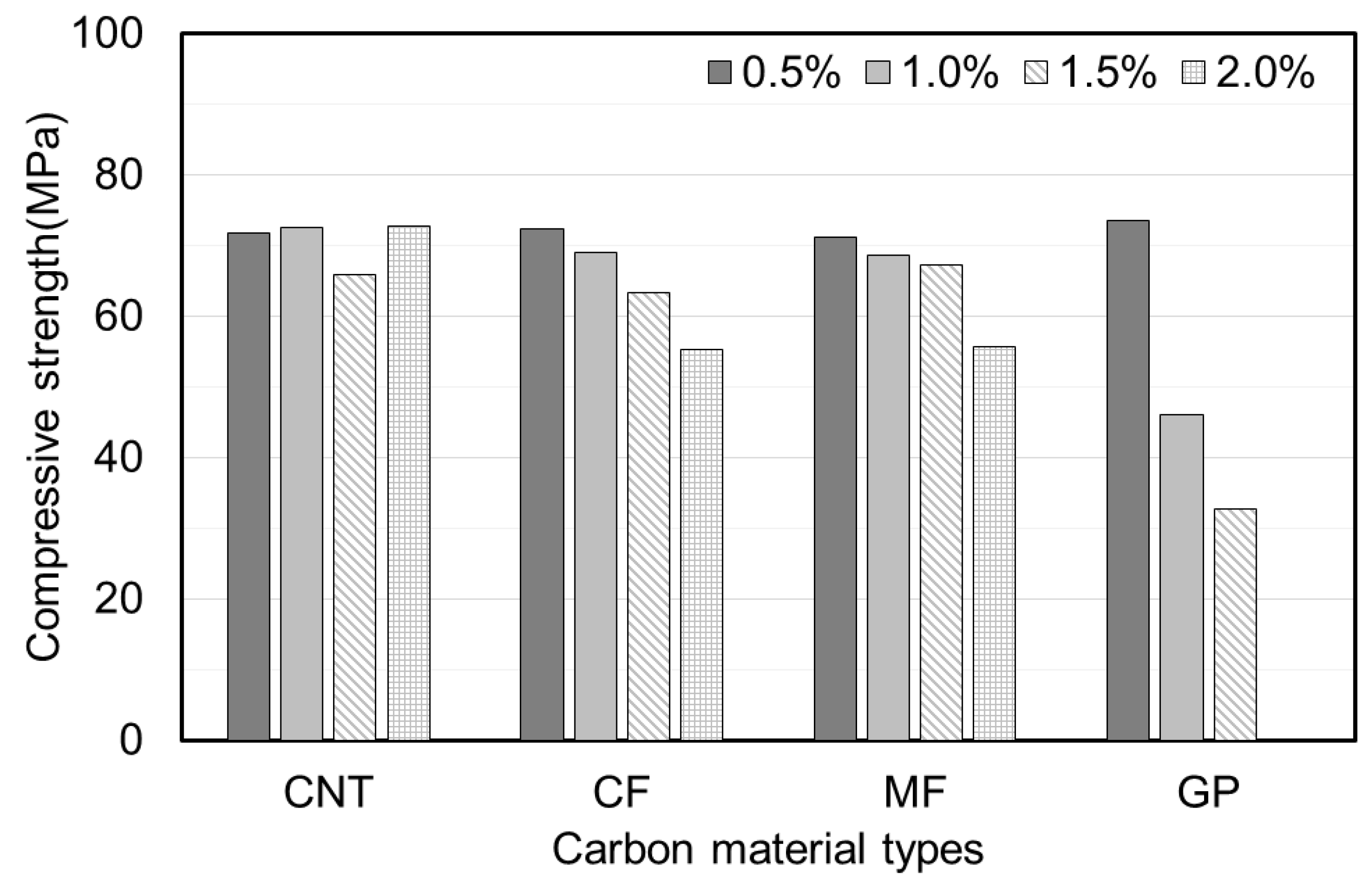
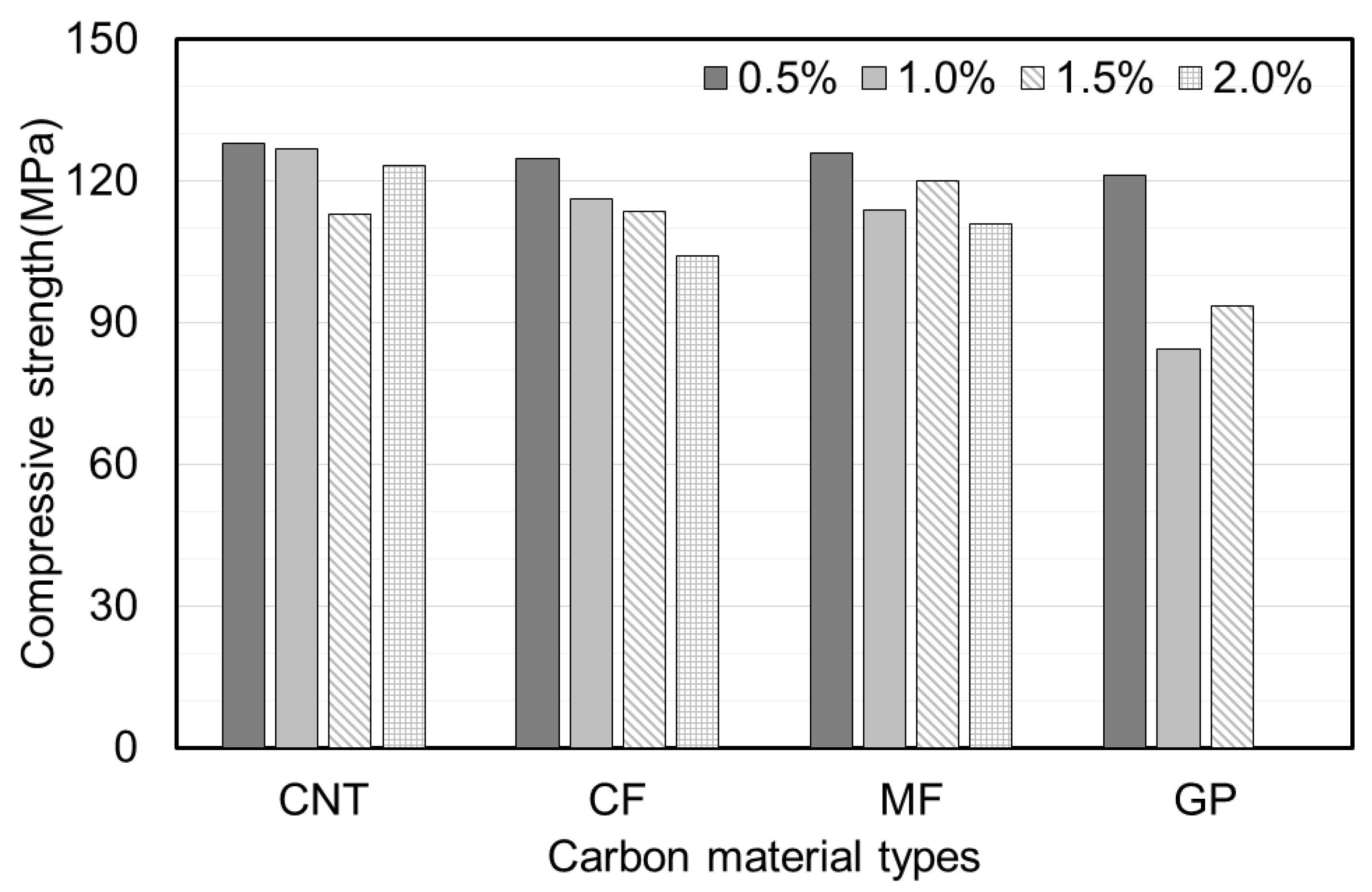
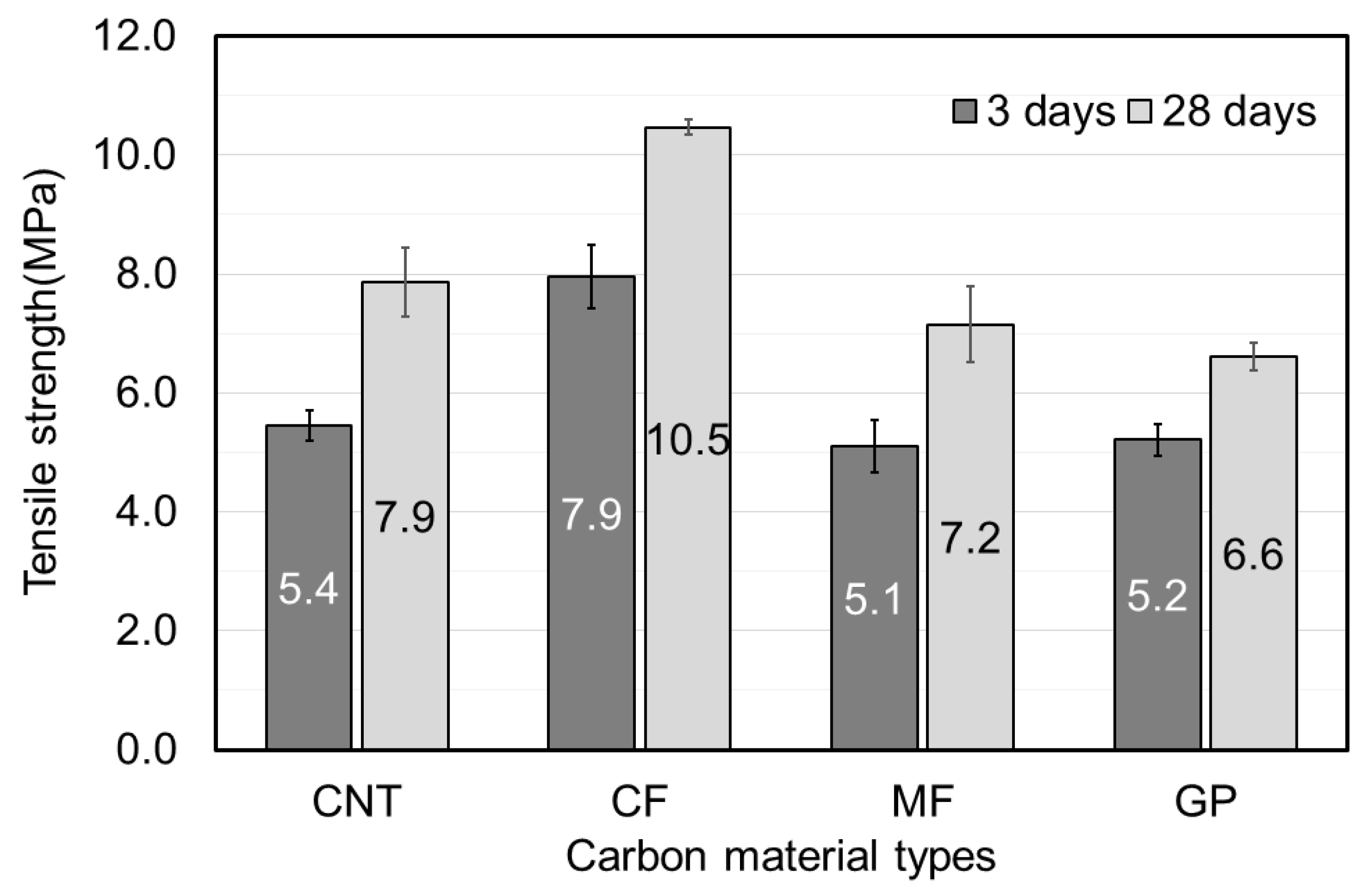

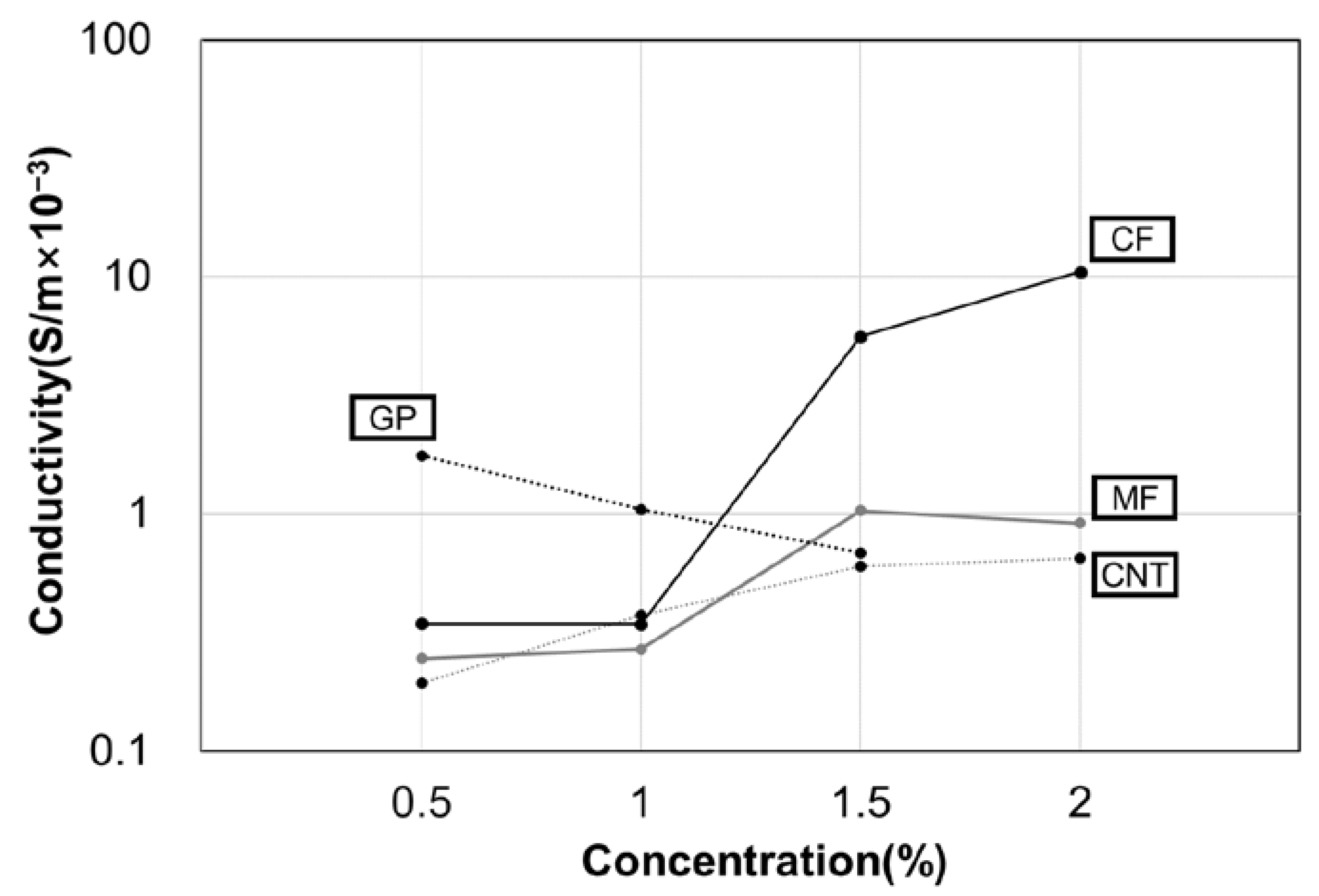
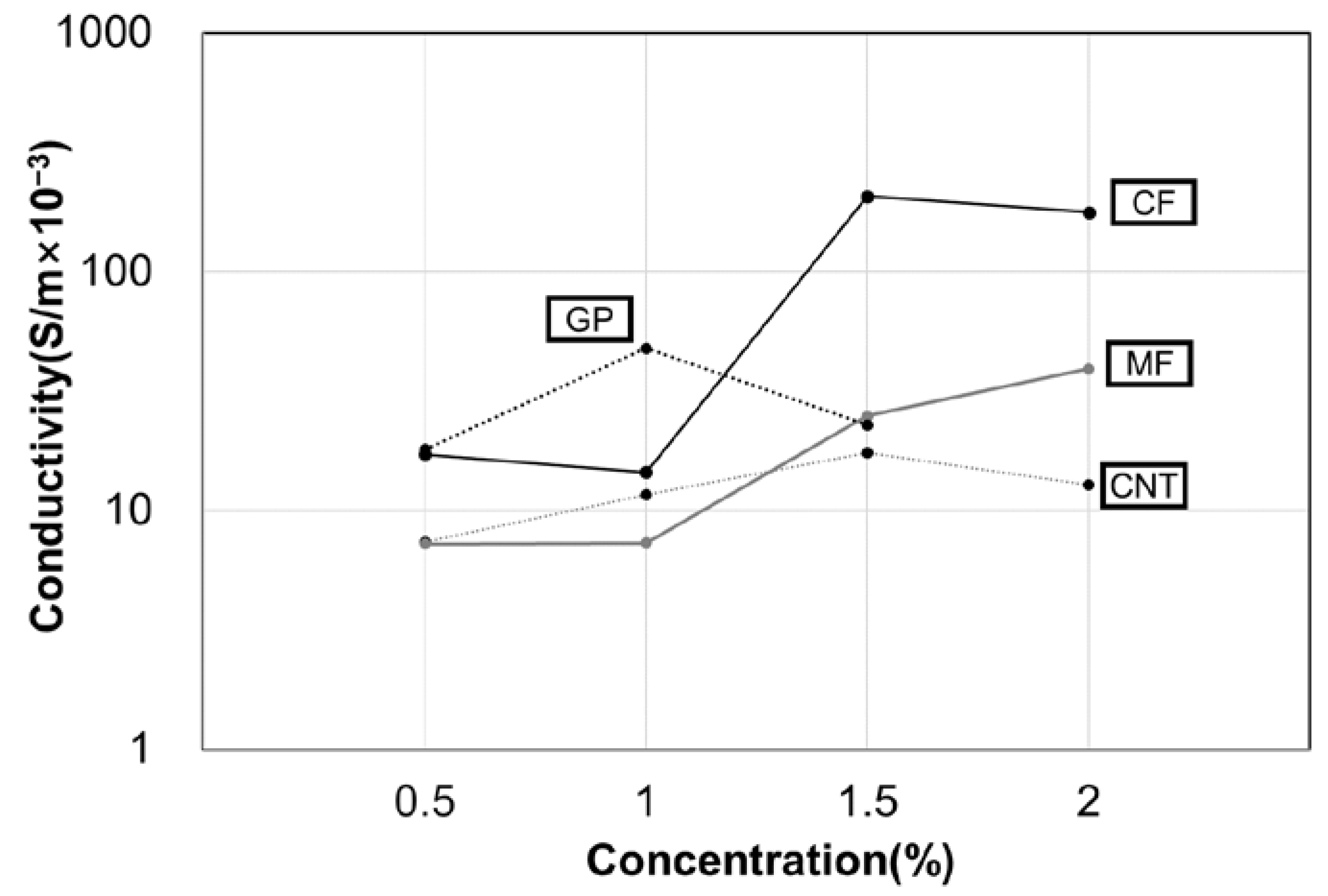
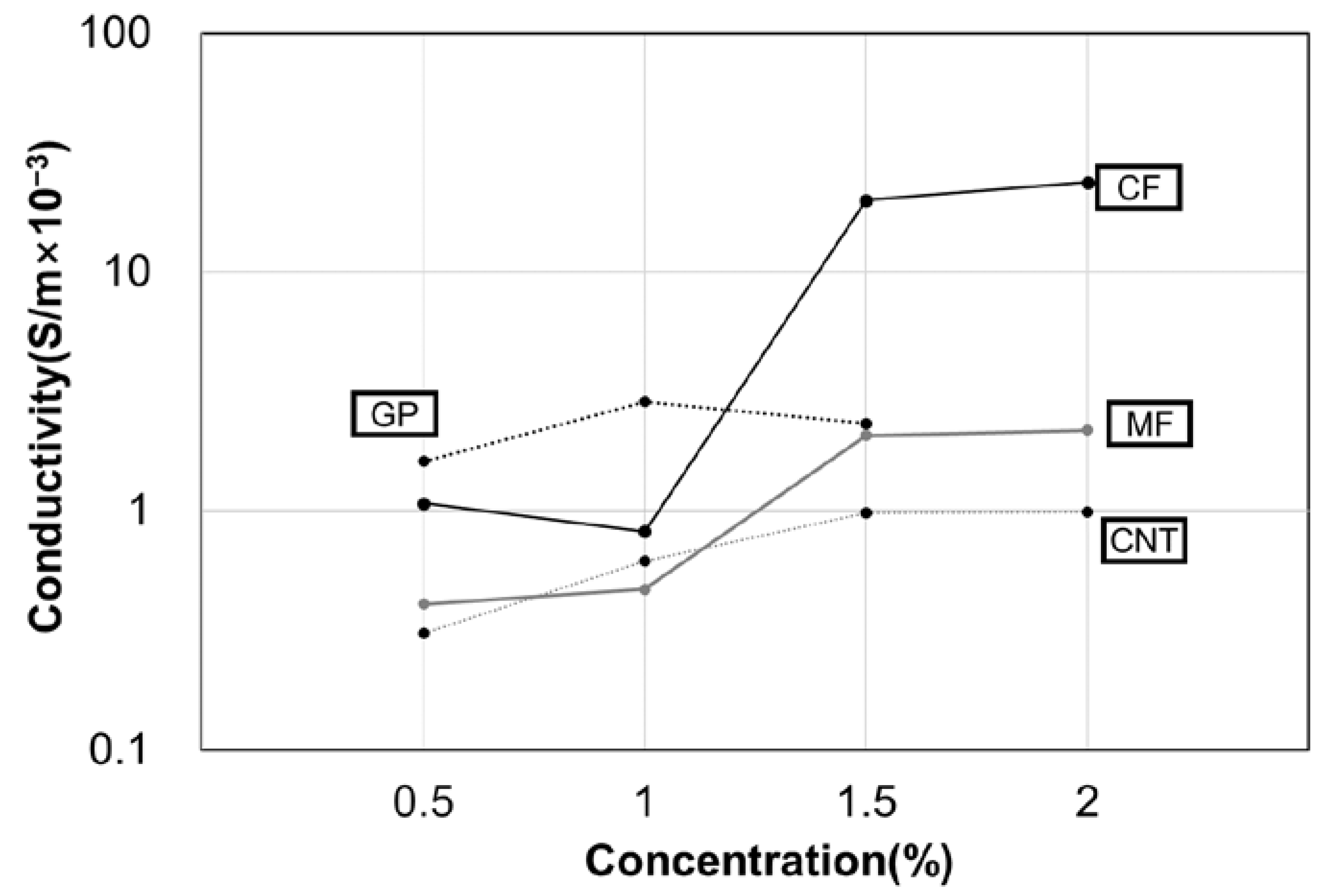
| W/B | Unit Weight (kg/m3) | |||
|---|---|---|---|---|
| Water | Premixed Binder | Fine Aggregate | Steel Fiber | |
| 0.23 | 210 | 1180 | 847 | 78 |
| Specimens | Carbon Materials | Volume Contents (%) | Specimens | Carbon Materials | Volume Contents (%) |
|---|---|---|---|---|---|
| 1 | CNT (Carbon nanotube) dispersion | 0.5 | 9 | Milled fiber | 0.5 |
| 2 | 1 | 10 | 1 | ||
| 3 | 1.5 | 11 | 1.5 | ||
| 4 | 2 | 12 | 2 | ||
| 5 | Chopped fiber | 0.5 | 13 | Expanded graphite | 0.5 |
| 6 | 1 | 14 | 1 | ||
| 7 | 1.5 | 15 | 1.5 | ||
| 8 | 2 | ||||
| Carbon Materials | Concentration (%) | At the Age of 3 Days | At the Age of 28 Days | Reduction Rate (%) | ||
|---|---|---|---|---|---|---|
| Resistance (Ω) | Conductivity (S/m × 10−3)-ⓐ | Resistance (Ω) | Conductivity (S/m × 10−3)-ⓑ | (ⓐ−ⓑ)/ⓐ | ||
| [CNT] | 0.5 | 27,429 | 2.92 | 415,625 | 0.19 | 93.4% |
| 1.0 | 15,985 | 5.00 | 213,636 | 0.37 | 92.5% | |
| 1.5 | 9242 | 8.66 | 133,000 | 0.60 | 93.1% | |
| 2.0 | 11,561 | 6.92 | 123,182 | 0.65 | 90.6% | |
| [CF] | 0.5 | 21,522 | 3.72 | 232,877 | 0.34 | 90.8% |
| 1.0 | 21,613 | 3.70 | 233,333 | 0.34 | 90.7% | |
| 1.5 | 1788 | 44.75 | 14,297 | 5.60 | 87.5% | |
| 2.0 | 1947 | 41.08 | 7644 | 10.47 | 74.5% | |
| [MF] | 0.5 | 28,955 | 2.76 | 325,926 | 0.25 | 91.1% |
| 1.0 | 24,792 | 3.23 | 298,551 | 0.27 | 91.7% | |
| 1.5 | 8880 | 9.01 | 77,857 | 1.03 | 88.6% | |
| 2.0 | 5681 | 14.08 | 87,500 | 0.91 | 93.5% | |
| [GP] | 0.5 | 8986 | 8.90 | 45,323 | 1.77 | 80.2% |
| 1.0 | 4870 | 16.43 | 76,674 | 1.04 | 93.6% | |
| 1.5 | 15,423 | 5.19 | 116,889 | 0.68 | 86.8% | |
| Carbon Materials | Concentration (%) | At the Age of 3 Days | At the Age of 28 Days | Reduction Rate (%) | ||
|---|---|---|---|---|---|---|
| Impedance, Z | Conductivity (S/m × 10−3)-ⓐ | Impedance, Z | Conductivity (S/m × 10−3)-ⓑ | (ⓐ−ⓑ)/ⓐ | ||
| [CNT] | 0.5 | 10,818 | 7.4 | 260,823 | 0.3 | 95.9% |
| 1.0 | 6884 | 11.6 | 129,849 | 0.6 | 94.7% | |
| 1.5 | 4577 | 17.5 | 81,727 | 1.0 | 94.4% | |
| 2.0 | 6278 | 12.7 | 80,992 | 1.0 | 92.2% | |
| [CF] | 0.5 | 4668 | 17.1 | 74,373 | 1.1 | 93.7% |
| 1.0 | 5535 | 14.5 | 97,736 | 0.8 | 94.3% | |
| 1.5 | 387 | 206.9 | 4005 | 20.0 | 90.3% | |
| 2.0 | 453 | 176.7 | 3376 | 23.7 | 86.6% | |
| [MF] | 0.5 | 11,066 | 7.2 | 196,317 | 0.4 | 94.4% |
| 1.0 | 10,967 | 7.3 | 170,319 | 0.5 | 93.6% | |
| 1.5 | 3224 | 24.8 | 38,819 | 2.1 | 91.7% | |
| 2.0 | 2038 | 39.3 | 36,788 | 2.2 | 94.5% | |
| [GP] | 0.5 | 4438 | 18.0 | 49,640 | 1.6 | 91.1% |
| 1.0 | 1673 | 47.8 | 27,999 | 2.9 | 94.0% | |
| 1.5 | 3504 | 22.8 | 34,432 | 2.3 | 89.8% | |
Publisher’s Note: MDPI stays neutral with regard to jurisdictional claims in published maps and institutional affiliations. |
© 2022 by the authors. Licensee MDPI, Basel, Switzerland. This article is an open access article distributed under the terms and conditions of the Creative Commons Attribution (CC BY) license (https://creativecommons.org/licenses/by/4.0/).
Share and Cite
Lim, K.; Lee, N.; Ryu, G.; Koh, K.; Kim, K. Electrical Characteristics of Ultra-High-Performance Concrete Containing Carbon-Based Materials. Appl. Sci. 2022, 12, 7858. https://doi.org/10.3390/app12157858
Lim K, Lee N, Ryu G, Koh K, Kim K. Electrical Characteristics of Ultra-High-Performance Concrete Containing Carbon-Based Materials. Applied Sciences. 2022; 12(15):7858. https://doi.org/10.3390/app12157858
Chicago/Turabian StyleLim, Kwangmo, Namkon Lee, Gumsung Ryu, Kyungtaek Koh, and Kyongchul Kim. 2022. "Electrical Characteristics of Ultra-High-Performance Concrete Containing Carbon-Based Materials" Applied Sciences 12, no. 15: 7858. https://doi.org/10.3390/app12157858
APA StyleLim, K., Lee, N., Ryu, G., Koh, K., & Kim, K. (2022). Electrical Characteristics of Ultra-High-Performance Concrete Containing Carbon-Based Materials. Applied Sciences, 12(15), 7858. https://doi.org/10.3390/app12157858






